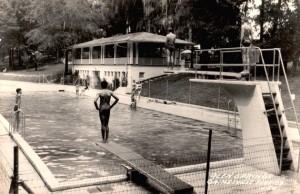Tom Petty and The Heartbreakers were inducted into the Rock and Roll Hall of Fame the same year that the Gainesville, Fla. musician and band mates would release their 2002 album titled “The Last DJ.” Rolling Stone columnist Greg Kot refers to the third track on the album, “Dreamville,” as “A reminder of rock’s youthful promise.” The lyrics, written by Petty, take you on a brief journey through the singer’s youth in the North Central Florida community, singing of his mama, the music store where he purchased strings for his guitar, and visits to a spring-fed swimming pool at Glen Springs. The swimming pool itself was built a few years after Cicero Addison Pound, a local and well respected businessman, had purchased the spring and the land surrounding it in 1924. The investor believed the beauty of the spring, hidden from the view of the public, was being wasted in the northwest section of the city. He created the original pool by the construction of a wooden damn, providing a small “swimming hole” which was roughly ten feet deep. With limited other places to swim at that time, the popularity of this damned off spring grew quickly.
It wasn’t long before Mr. Pound contacted University of Florida Architectural Engineer Guy Chandler Fulton to further develop the spring into a swimming pool. The result was a simple spring-fed pool with a few wooden structures where bathers could change into their swimming suits. As the years would pass, the popularity of the Glen Springs pool would continue to grow. In 1940, Pound again contracted Fulton to transform the simple pool and it’s surrounding area into a first class recreational facility. Added to the site were sidewalks, a walkover area, a cement diving board, and an improved enclosure for the spring head itself. Linda Califf, officer and past trustee of the Gainesville Elks Lodge, and “unofficial” historian of the site, states that one of the most notable improvements made to the pool was its unique drainage system. As she explains it: “Inside the spring head area, he installed a drainage box which is situated below the water spillway. At the bottom of the box is a tip valve. When this valve is opened, it diverts the water from the spring head into the box and the water flows through a piping system under the pool and empties into the Glen Springs Run. Midway through the pools, he installed a walkover with a manhole cover and another drainage function. Inside the manhole cover is a turn valve. When opened, it drains the water from the smaller pool into this piping system. Near the diving board is another manhole cover with the same valve system. It drains the water from the deeper pool. Inside the walkover, there are two flow-through areas on each side which allow the water to flow from the shallow pool into the larger pool. At the end of the larger pool, there are two additional flow-throughs, which allow the water to enter another piping system that dumps into the creek bed. These flow-throughs must be cleaned almost daily to keep the water flowing freely from one end of the pool to the other. With this unique system in place, the pools could be drained individually and cleaned.”
Fulton’s original plans for the site remain on file at the UF Smathers Library.
In the early 1960s, Cicero Pound offered the location as a trade for a building located downtown which, at the time, was owned by the Gainesville Elks Lodge. The recreational building at the site quickly became the meeting hall and social quarters. In 1968, a larger building was built to house the Lodge’s activities, as well as the addition of a large deck so that visitors could sit and enjoy the beauty of the pool. In 1970, shortly after the construction was completed, Gainesville Code Enforcement notified the Elks Lodge that the pool could no longer be utilized as a swimming facility because the spring water could not be chlorinated.
The Lodge membership continued to grow and it was decided that the building that overlooked the pool would need to be relocated and renovated to house the meetings and activities. The pool, in which no one was permitted to swim, was out of sight, out of mind, so to speak, and fell into disrepair. To further complicate the matter, pollution from fertilizers, pesticides, and roadway runoff have drastically increased the nitrate levels in the waters of the spring.
John, a current member of the Elks Lodge, took me on a tour of the pool area. Heavy leaf fall covered the floor of the three-section pool, obscuring the construction debris, specifically cinder blocks, that had been thrown in. As we walked, the Lodge member voiced his concerns about the possible future of the pool. “The Elks bring kids in from the community for fishing tournaments,” he stated, adding that he would like that to continue. The Lodge would stock the pool with fish from time to time over the years to support the community interaction. The swimming pool is now home to several remaining bass and bream, including a seven pound female that lurks beneath the skeletal remains of the large concrete dive stand that hangs ominously over the deepest section.
Friends of Glen Springs (FROGS) is a community coalition founded by Marilyn Tubb and Jeff Montgomery to restore Glen Springs to its natural beauty after four decades of neglect. Members of this this broad-based coalition include representatives from all Rotary clubs in the city; the Elks Lodge; the University of Florida; The City of Gainesville; Alachua County; Gainesville Regional Utilities; The Florida Springs Institute; The Sierra Club; The Audubon Society; The Chamber of Commerce; private sector engineering and consulting firms; landscape designers; artists; environmentalists; business people and longtime Gainesville residents.
(I also became involved. While doing the research on the history of this swimming pool, I became intrigued, not only with its historic significance, but with its future and its effects on Hoggetowne Creek, into which it feeds. I partnered with the Florida Department of Environmental Protection to help monitor the water quality of the runoff, as well as helping Department of Environmental Protection’s efforts in teaching the public about the importance of water and conservation.)
“We have no interest in recreating or renovating an actual swimming pool,” co-founder Jeff Montgomery stated when I spoke to him about the efforts of FROGS. The mission of the group is to restore this area to a more park-like setting, preserving features from the historic pool, and creating an area that the public can once again enjoy. The group’s goal is to provide an area with nature trails, natural vegetation, native limestone, picnic tables, a spring area, and an educational pavilion that focuses on Florida’s springs. The group is currently seeking support for a restoration study to be conducted by local professional experts to determine the scope, requirements and cost of a renovation project. The estimated cost of the study is between $75,000 and $100,000.
At Jeff Montgomery’s suggestion I contacted Bruce J. Morgan, internationally recognized environmental artist and landscape designer, to learn his vision on the restoration of Glenn Springs. “The existing pool shell,” Bruce explained, “has been undermined and is rotten to the core. It is a liability and cannot be repaired. I have proposed the demolition of the deep section, and that alone will require the removal of the existing building. I further proposed that the middle section of the pool walls remains in place to retain the adjacent slopes, but that they be subsumed beneath a restored spring run. The upper shallow section still appears to be structurally sound so it would be refurbished as a wading pool. The walls surrounding the spring would be left intact as a historic artifact.”
Bruce’s design involves replacing the existing buildings with pavilions and multipurpose gathering spaces occupying only the footprint of the existing buildings. Restrooms, mechanical equipment, vending, and storage would all be underground, covered with a green roof. His design would include Parthenocissus vines and trumpet creeper (natural Florida vegetation), chert boulders, and the design itself would be completely natural. Referring to his vision, the environmental artist stated, “I want the ghosts of the past to echo through the site along with the gurgle of the spring!”
Do I hear Tom Petty or is that just the wind?
Rudy Stankowitz is the CEO and president of Aquatic Facility Training & Consultants in Archer, Fla.



